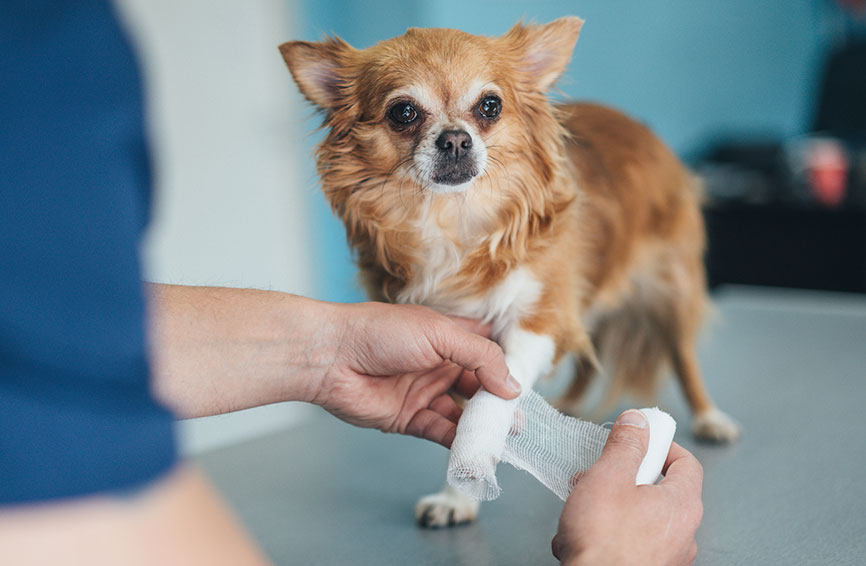Table of Contents
Accidents in dogs often result in a need for emergency care for wounds, bleeding or broken bones. If this happens to you and your pet, you’ll want to be prepared for the quick action needed and the potential costs of taking your dog to an emergency vet.
Consider the case of Tippy, a smart, fetch-obsessed, people-loving lab mix, according to pet parent Anna.
One summer Tippy was seriously hurt. She was fetching a stick and landed on it wrong. “It pierced an 8-inch hole under her tongue and into her throat – there was a lot of blood and she was crying,” says Anna.
She took her to a SF SPCA Veterinary Hospital, that was open 24 hours for emergencies.
What to expect at the vet hospital
“When the vet at the hospital told me how deep the wound was and that Tippy would need emergency surgery, I freaked out!” says Anna. “Tippy came through the surgery okay, but it was a very sleepless night for me.”
The shock of simply getting your pet to the vet after a traumatic incident may leave you shaking. Because of the nature of these injuries, vets move fast, and you may have to make quick decisions. If your pet has been seriously wounded, surgery will likely be necessary, and they are very common at most facilities, so keep heart. This is what you can expect:
- First, the vet and vet techs will be ready for you due to your phone call. Upon your arrival, the vets will assess your pet quickly. If the techs have cause for concern, they may admit your pet immediately to stabilize their vital signs (heart, respiratory rate, blood pressure, body temperature). Treatments to help stabilize pets include oxygen, intravenous fluid therapy, and intravenous pain relief.
- The veterinarian will then examine your pet, and they will discuss with you any tests, treatment, and ongoing care. At this point, it’s also likely the hospital staff will give you an estimate for the cost of the surgery (if needed) and the entire visit.
- Surgery will likely happen quickly if it’s urgent and necessary. The surgeon will advise you on the type, length, goals, and risks of the procedure. Pets will have some of their fur clipped or shaven to make sure that the surgical area is as clean and free of microorganisms as possible.
- In most cases, if the pet is stable and in good condition to travel, they are transferred back to their regular vet once they’re open (usually the next working day). There can still be a hospital stay at either facility, though, with an overnight staff caring for your pet.
- Finally, the discharge day. Upon transfer or discharge, you’ll receive your pet’s full clinical history and an invoice detailing all the tests and treatments given. Usually, the ER will fax or email this information to your regular vet, but getting an extra copy is wise for pet parents.

Cost of emergency treatment
While emergency surgery is essential, it is also expensive, usually totaling over $1,000. Emergencies can happen to any pet, regardless of the situation, breed, or species, and pet insurance is designed for these exact moments. Anna was reimbursed $1,312 of the $1,646 bill for Tippy: “Healthy Paws was great through the whole process. I was so relieved that I’d signed up with them: they checked in with me and Tippy to see how she was doing and sent me a check that covered a large portion of her medical expenses. For me, getting Healthy Paws was so, so worth it, and I have peace of mind knowing I have it still.”
The value of pet insurance
Pet insurance can save you thousands of dollars if your pet gets sick or injured unexpectedly. For as little as $25/month for dogs and $15/month for cats, the investment in pet insurance can save you up to 90% of vet bills and help you say yes to life-saving medical treatments. It’s important to note that pet insurance doesn’t cover pre-existing conditions, so the sooner you sign up your pet, the better. Getting a quote is quick and easy.
In case of emergency: wounds, broken bones or bleeding
Whenever there is an accident or injury, pet parents need to try to keep a cool, calm head and get to the vet as soon as possible, especially because serious wounds can be fatal. Whether your pet has been bitten by another animal or had a rough fall, emergency hospitals are well-equipped to help get your best furry friend stable. Here are the first steps you should take in the event of a wound or accident:
- Approach your pet with caution. Pets who are in pain can become aggressive, even if they’re normally sweet and cuddly.
- Check your pet’s vital signs. A rapid heartbeat, rapid breathing, and pale or white gums (indicates low blood pressure) are signs of shock. Shock requires immediate treatment.
- If your pet appears unconscious, get on the phone immediately with a vet clinic and have the staff talk you through CPR.
- If your pet is bleeding, apply direct pressure using gauze and elevate the bleeding wound. If the gauze soaks completely through, do not remove it– simply add more gauze on top of it until you get to the hospital. Removing the gauze will disrupt the natural blood clotting process, causing the bleeding to start all over again.
- Call the nearest vet hospital so they can prepare for your arrival. Provide as much detail as you can about what happened to your pet.
- Write down all care instructions and follow them as closely as you can, all the while preparing to get your pet to the hospital as quickly as possible.
Although it is best for you to remain calm, it’s completely understandable if you feel panicky and unsure of what to do. If you feel uncomfortable with what to do first, call your vet or an emergency vet hospital and have them walk you through each step of what to do before you arrive at the hospital.
Before an emergency happens, you’ll want to check out how to craft a splint or tourniquet and be prepared with a first aid kit. This kit should include essentials like food, water, towels, bandages and gauze, ointments and scissors. We also recommend the American Red Cross’ “Pet First Aid” and Pet Emergency Pocket Guide (full shopping list for a good first aid kit is available on Be Prepared: Emergency Pet Safety).
Remember it’s imperative to get your pet to the emergency vet hospital as quickly as you can. The sooner you can get your pet to the hospital, the sooner they can get the care they need to recover from their emergency.
The content is not intended to be a substitute for professional veterinarian advice, diagnosis, or treatment. Always seek the advice of your veterinarian or other qualified health provider with any questions you may have regarding a medical diagnosis, condition, or treatment options.
In addition to being prepared for an emergency with our Be Prepared: Emergency Pet Safety tips, don’t forget to enroll in pet insurance. Having a Healthy Paws policy means you can be reimbursed up to 90% on vet bills, or have the vet hospital be paid directly by us, so you won’t have to say no to a life-saving procedure. Start by getting a quote.
Are you a Healthy Paws pet parent with a recovery story to tell? We’d love to hear it! Send your pet’s story along with photos of your four-legged family member to happytales@healthypaws.com









